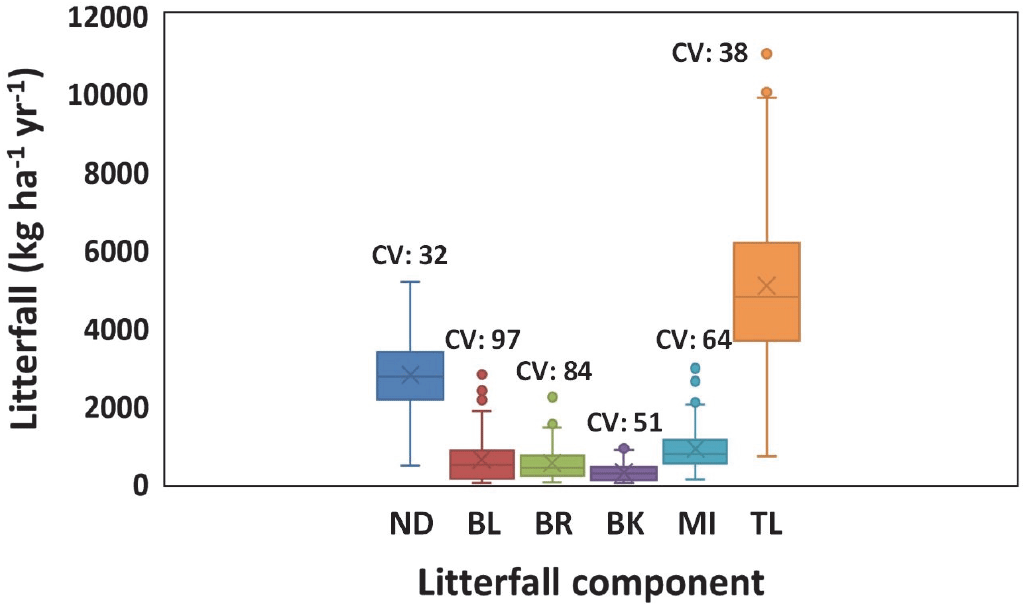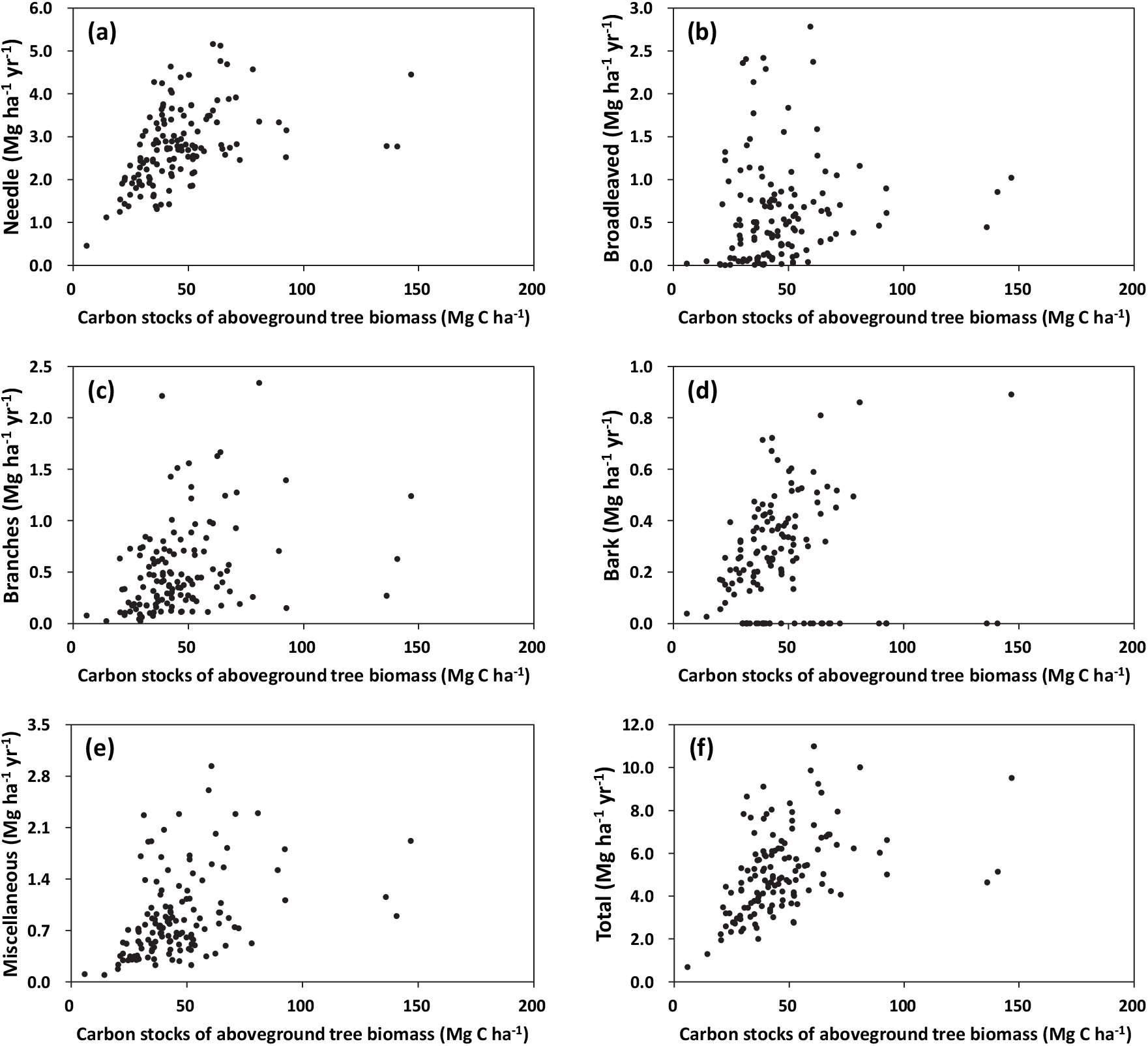Introduction
Litterfall inputs are a key parameter for measuring, modeling, and estimating soil carbon sequestration, nutrient cycles, and nutrient flows in forest stands (Berg and Laskowski, 2006; Kim et al., 2012; Lado-Monserrat et al., 2016). Thus, litterfall inputs have received considerable research attention at stand (Kim et al., 2012), regional (Lehtonen et al., 2004; Starr et al., 2005; Erkan et al., 2017), continental (Neumann et al., 2018), and global scales (Li et al., 2019). Many studies have developed statistical models to identify the key drivers of litterfall inputs through stand characteristics and climatic factors (Berg and Laskowski, 2006; Erkan et al., 2017; Li et al., 2019). However, annual litterfall inputs vary considerably depending on stand characteristics, such as basal area, stem volume, and aboveground biomass (Kim et al., 2012; Erkan et al., 2017), whereas there was a large variability between litterfall production and mean values of climatic factors. The use of stand characteristics may result in more realistic litterfall estimates because the amount of litterfall inputs depends on several ecological properties and forest management activities, such as tree species, site quality, stand age, stand density, fertilization, and thinning (Kim et al., 2012; Bueis et al., 2018; Çömez et al., 2019). In addition, it is difficult to use climate data for the actual site and annual litterfall values at regional scales (Starr et al., 2005).
Although many linear and multiple regression models have been developed to estimate litterfall inputs from environmental and structural variables of forest stands, such as stand age, basal area, canopy cover, site index, growing stock, climate factor, and altitude (Berg and Laskowski, 2006; Erkan et al., 2017; Neumann et al. 2018; Li et al., 2019), developing models to characterize litterfall inputs are challenging owing to high variability in space and time in the input patterns of litterfall. Allometric relationships between litterfall components and aboveground biomass may provide a new conceptual understanding of litterfall inputs (Erkan et al., 2017; Fu et al., 2017) because allometric relationships exist among different tree organs. In addition, tree biomass functions are widely available from field observations or forest inventory data of Korea (Korea Forest Research Institute, 2010; Kim et al., 2017).
Although many studies have examined the drivers of litterfall inputs based on a stand scale (Mun et al., 2007; Kim, 2016), few studies have analyzed litterfall inputs across regional scales in Korea. The objectives of this study were to develop allometric models to predict litterfall inputs in Korean red pine (Pinus densiflora S. et Z.), which is a representative coniferous species distributed widely in Korea. In this study, we examined that annual litterfall inputs of Korean red pine stands may be predicted using stand parameters.
Materials and Methods
The litterfall used in this study was compiled from data with varying sampling for 2-4 years (Table 1) collected from 45 plots on seven regional scales (Goseong-gun, Hadong-gun, Hamyang-gun, Jinju-si, Sacheon-si, Sancheong-gun, and Uiryeong-gun) in Gyeongsangnam-do. The mean annual precipitation and temperature for 30 years in the study areas were 1,320 mm year−1 and 12.8°C for Hamyang-gun, 1,556 mm year−1 and 12.8°C for Sancheong-gun, 1,493 mm year−1 and 13.5°C for Jinju-si, and 1,436 mm year−1 and 13.6°C for Uiryeong-gun, respectively (Korea Meteorological Administration, 2011). The soils in the study site are well-drained, slightly wet, or dry brown forest soil (mostly Inceptisols USDA soil taxonomy) originating from granite or granite gneiss for Hamyang-gun, Hadong-gun, Sancheong-gun, and Uiryeong-gun, with a loamy texture, whereas the soils in Goseong-gun and Jinju-si are slightly dry dark reddish brown forest soil (mostly Inceptisols USDA soil taxonomy) originating from sandstone or shale. The study sites were pure or almost pure Korean red pine stands with a few other tree species, mainly Quercus spp. Stand age ranged from 25 to 80 years, with various mean diameter at breast height (DBH) and basal areas (Table 1). To measure litterfall inputs, three or five circular litter traps with a surface area of 0.25 m2 were installed 60 cm above the forest floor at various sizes of sample plots (10×10 m, 10×20 m, and 20× 20 m). Litter traps were of the same type in all sampling years and plots. The sampling frequency varied at one- or three-month intervals throughout the year. The litter from each trap was transported to a laboratory and then ovendried at 65°C for 48 h. All dried samples were separated into needle, broadleaved, branches, bark, and miscellaneous litter with reproduction components (flower and cone), and each portion was weighed.
A total of 102 observations of annual litterfall from 45 plots were used to develop allometric models to predict litterfall component inputs for Korean red pine stands, based on the stand parameters. The stand parameters included: 1) basal area, 2) stand density, 3) mean DBH, and 4) carbon stocks of aboveground tree biomass, such as needles, branches, stems, and total tree biomass. Carbon stocks of aboveground tree biomass in each stand were estimated using allometric equations based on DBH (1.2 m) for individual trees of Korean red pine in Gyeongsangnam-do, as reported by Kim et al. (2017). Litterfall data were log-transformed to achieve normality because of a broad variation in stand structure and environmental factors.
The allometric regression model to predict the annual litterfall input was as follows:
where y is the annual litterfall input (kg ha−1year−1), x is the stand parameter, a is a constant, and b is a coefficient.
The accuracy of the allometric equations was evaluated using the coefficient of determination (R2) and root mean square error (RMSE) (Socha and Wezyk, 2007). Bias correction factors (CF) in the logarithmic transformation were calculated using the standard error of the estimate (Garcia Villacorta et al., 2015). Pearson correlation analysis using non-log-transformed data was performed between litterfall input and stand parameters (SAS Institute Inc., 2003).
Results
The annual inputs of needles, broadleaved, branches, bark, miscellaneous, and total litter are shown in Figure 1. The mean annual litterfall was highest at 2,779 kg ha−1 year−1 for needle litter, followed by 883 kg ha−1 year−1 for miscellaneous litter, 611 kg ha−1 year−1 for broadleaved litter, 513 kg ha−1 year−1 for branch litter, and 340 kg ha−1 year−1 for bark litter. The mean annual total litterfall ranged from 696 kg ha−1 year−1 to 11,014 kg ha−1 year−1, with a mean value of 5,051 kg ha−1 year−1. The coefficient of variation was lowest in needle litter (32%), followed by total litterfall (38%), bark litter (51%), miscellaneous litter (64%), branch litter (84%), and broadleaved litter (97%). The coefficient of variation calculated across the regional scales showed the highest coefficient variation in broadleaved litterfall because there were no regular input patterns compared with other litterfall components (Figure 2).


Litterfall components were significantly correlated (P < 0.05) with stand parameters, except for broadleaved litter (Table 2). The carbon stock of aboveground tree biomass showed a stronger correlation with all litterfall components than the other stand variables, such as basal area, stand density, and mean DBH (Table 2). The allometric equations for all the litterfall components were significant (P < 0.05) with stand parameters accounting for 5-43% of the needle litter and 8-42% of the variation in total litter, except for stand density (Table 3). Based on the R2, generally the best fits for litterfall components were obtained for carbon stock of aboveground tree biomass.
Allometric equation form is log10y = a + b log10x. y: litterfall components, x: variable of stand characteristics. The R2 is the coefficient of determination. P-values represent the significance of the equations. Root means squared error (RMSE); Correction factor (CF).
Discussion
The mean inputs of total litterfall (5,051 kg ha−1 year−1) in this study fall within the published range (4,038–5,589 kg ha−1 year−1) of values recorded for Korean red pine forests (Jeong et al., 2009; Kim et al., 2012). It is also similar to the average litterfall (5,500 kg ha−1 year−1) in other temperate coniferous forests (Bray and Gorham, 1964). The coefficient of variation in needle or total litter inputs in the present study was slightly lower than in other studies, which was 36% for needle litterfall and 45% for total litterfall in Pinus brutia in Turkey, as observed by Erkan et al. (2017).
Inputs of litterfall components were significantly correlated with most of the variables included in the study, whereas non-significant correlations were found in broadleaved litterfall. Similar results were reported by other studies, in which leaf fall of most non-dominant tree species varied to a greater extent with the size of the gap and the intensity of forest management practices (Kim, 2016; Lado-Monserrat et al., 2016; Bueis et al., 2018). For example, Kim (2016) reported that the inputs of broadleaved litter in P. densiflora stands were not correlated (P > 0.05) with thinning intensity. In contrast to broadleaved litterfall, other litterfall components were well correlated with stand characteristics involved in canopy closure, except for needle and branch litterfall of stand density, and branch litterfall of mean DBH. The annual needle or total litterfall in many studies has been found to correlate with factors involving stand characteristics, such as basal area, stand volume, and stand biomass on a stand scale (Kim, 2016; Bueis et al., 2018; Kim et al., 2019). However, the stand density of Korean red pine stands on a regional scale was not an important variable for predicting litterfall inputs because this variable could be related to forest management activities, such as thinning practices. In contrast, carbon stocks of aboveground tree biomass showed a stronger correlation with litterfall compared to the other stand variables. Other studies found similar results, where litterfall inputs were closely related to growth variables, such as basal area and stand volume (Kim, 2016; Erkan et al., 2017).
In allometric models for the total and needle litterfall, basal area and carbon stocks of aboveground tree biomass appeared to be effective predictors of spatial variation in litterfall inputs on a regional scale. Similar results were observed by Kim (2016), who found that following forest tending works, Korean red pine stands showed a strong linear correlation between needle litterfall and stand basal area (r2= 0.72) on a stand scale. Erkanet al. (2017) presented regression models (r2= 0.78) explaining litterfall production by aboveground biomass related to canopy closure of Pinus brutia forests in Turkey. However, stand density and mean DBH, which were not related to canopy closure, were not important predictive variables in litterfall input models of Korean red pine stands.
Conclusions
Allometric regression models based on stand characteristics were developed for predicting annual litterfall input in mature Korean red pine stands on a regional scale. Carbon stocks of aboveground tree biomass were the most important variables explaining litterfall inputs on a spatial scale, whereas stand density and mean DBH were less reliable in terms of model accuracy. The results suggest that models developed from the basal area or carbon stocks of aboveground tree biomass may be used effectively for quantifying litterfall inputs in Korea red pine stands.